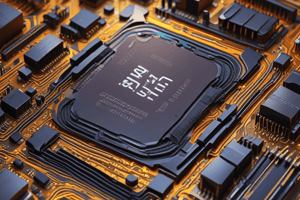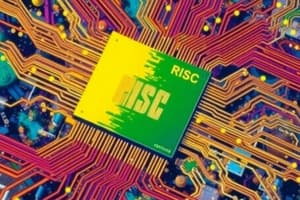Podcast
Questions and Answers
When a microprocessor board is powered up, what happens to the reset vector stored in EPROM?
When a microprocessor board is powered up, what happens to the reset vector stored in EPROM?
- It is transferred to the RAM through hardware (correct)
- It is transferred to the CPU for execution
- It is deleted from the EPROM
- It is sent to a peripheral device
What is the main goal of platform-based design in embedded systems?
What is the main goal of platform-based design in embedded systems?
- To allow the reuse of software and hardware components (correct)
- To reduce the power consumption of the system
- To reduce the cost of the system
- To increase the processing speed of the system
What is software/hardware co-design concerned with?
What is software/hardware co-design concerned with?
- Both hardware and software design concerns (correct)
- Only hardware design concerns
- Neither hardware nor software design concerns
- Only software design concerns
What does API stand for in the context of platform-based design?
What does API stand for in the context of platform-based design?
What is task-level concurrency management concerned with in embedded systems?
What is task-level concurrency management concerned with in embedded systems?
Where is the reset vector initially stored when a microprocessor board is powered up?
Where is the reset vector initially stored when a microprocessor board is powered up?
What type of design allows for the reuse of software and hardware components in embedded systems?
What type of design allows for the reuse of software and hardware components in embedded systems?
What is the primary concern of software/hardware co-design in embedded systems?
What is the primary concern of software/hardware co-design in embedded systems?
In which design activity can loops be interchanged?
In which design activity can loops be interchanged?
What design activity transforms floating point arithmetic to fixed point arithmetic?
What design activity transforms floating point arithmetic to fixed point arithmetic?
Which design activity maps operations to hardware or software?
Which design activity maps operations to hardware or software?
What is approximated during hardware/software partitioning and task-level concurrency management?
What is approximated during hardware/software partitioning and task-level concurrency management?
What is the primary goal of high-level transformations?
What is the primary goal of high-level transformations?
Which design activity is responsible for analyzing a set of possible designs?
Which design activity is responsible for analyzing a set of possible designs?
What is the primary focus of hardware/software partitioning?
What is the primary focus of hardware/software partitioning?
In which design activity is the scheduling process approximated?
In which design activity is the scheduling process approximated?
What is the characteristic of RISC processors?
What is the characteristic of RISC processors?
What is the 80/20 rule in RISC architecture?
What is the 80/20 rule in RISC architecture?
Which of the following processors has a CISC architecture?
Which of the following processors has a CISC architecture?
Which company is credited with defining RISC architecture?
Which company is credited with defining RISC architecture?
Which of the following processors executes its instructions in a single cycle?
Which of the following processors executes its instructions in a single cycle?
How is memory accessed in RISC architecture?
How is memory accessed in RISC architecture?
Which of the following processors has a Harvard architecture?
Which of the following processors has a Harvard architecture?
What is the main advantage of RISC architecture?
What is the main advantage of RISC architecture?
Flashcards are hidden until you start studying
Study Notes
RISC Architecture
- SPARC and MIPS processors are the first generation processors of RISC architecture.
80/20 Rule
- 80% of instructions are generated and only 20% of the instruction set is executed.
- This leads to the formation of RISC (Reduced Instruction Set Computing) which simplifies instructions to increase processor performance.
Complex Architecture
- SPARC has RISC architecture which has a simple instruction set.
- MC68020, MC68030, and 8086 have CISC (Complex Instruction Set Computing) architecture which is more complex.
RISC Definition
- IBM defined RISC architecture in the 1970s.
Single Cycle Execution
- MIPS R2000 executes its instructions in a single clock cycle.
- It synthesizes complex operations from the same reduced instruction set.
Memory Access in RISC
- Data is loaded into a register and manipulated, then written out to the main memory.
- This is done using load and store instructions.
Harvard Architecture
- RAM (Random Access Memory) has a Harvard architecture.
- When the board is powered up, the reset vector from the EPROM makes the initialisation of the board and is transferred to the RAM from the EPROM.
Platform-Based Design
- It allows the reuse of software and hardware components.
- It helps in coping with the increasing complexity in the design of embedded systems.
Software/Hardware Codesign
- It is a design that considers both hardware and software during the design process.
- It helps in finding the right combination of hardware and software for an efficient product.
API
- API stands for Application Programming Interface.
- It helps in extending the platform towards software applications.
Task-Level Concurrency Management
- It is concerned with identifying the tasks at the final embedded systems.
- It helps in identifying the tasks that need to be present in the final embedded systems.
High-Level Transformation
- It is responsible for high optimizing transformations.
- It can interchange loops and transform floating point arithmetic to fixed point arithmetic.
Hardware/Software Partitioning
- It is in charge of mapping operations to hardware or software.
- It helps in deciding whether to implement an operation in hardware or software.
Scheduling
- It is performed in several contexts.
- It should be approximated with other design activities like compilation, hardware/software partitioning, and task-level concurrency management.
Studying That Suits You
Use AI to generate personalized quizzes and flashcards to suit your learning preferences.




